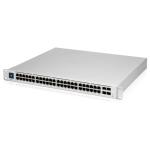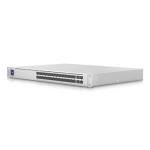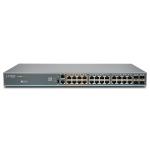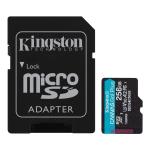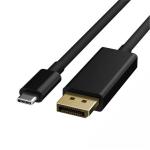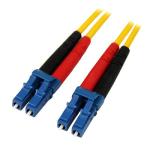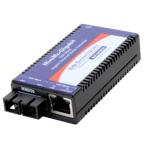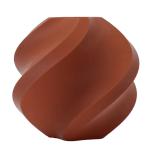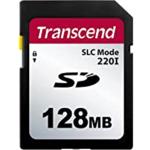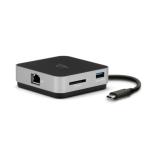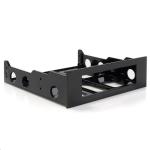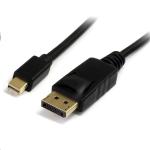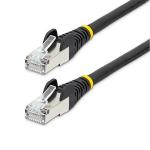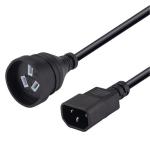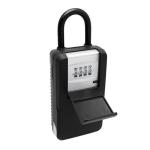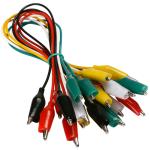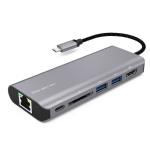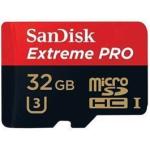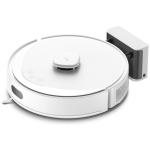Juniper Networks EX2300-24MP multi-gig switch with 16 x 1G, 8x 1G/2.5G copper ports, 30w PoE
Out of stock
Juniper Networks EX2300-24MP multi-gig switch with 16 x 1G, 8x 1G/2.5G copper ports, 30w PoE
- Brand: Juniper Networks
- MPN: EX2300-24MP
- Part #: SWHJUN2300242
- UPC:
View all shipping info
- Brand: Juniper Networks
- MPN: EX2300-24MP
- Part #: SWHJUN2300242
- UPC:
Similar in-stock products available at PB Tech right now
Features
Specifications
Reviews
Delivery & Pick-up
Returns & Warranty
Popular Switches
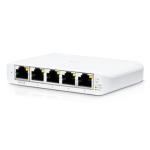



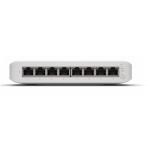
Juniper Networks EX2300-24MP multi-gig switch with 16 x 1G, 8x 1G/2.5G copper ports, 30w PoE
- Brand: Juniper Networks
- MPN: EX2300-24MP
- Part #: SWHJUN2300242

Product URL: https://www.pbtech.com/au/product/SWHJUN2300242/Juniper-Networks-EX2300-24MP-multi-gig-switch-with
Features
The Juniper Networks EX2300 Ethernet Switch offers an economical, entry-level, standalone solution for access-layer deployments in branch and remote offices, as well as enterprise campus networks. Both 1 Gbps and 2.5 Gbps access port options are available to provide higher-speed options, especially when connecting to 802.11ac Wave 2 access points.
For small networks, up to four EX2300 switches can be interconnected in a Virtual Chassis configuration, allowing them to be managed as a single switch.
The EX2300 is onboarded, provisioned, and managed in the Juniper Mist Cloud Architecture. Mist Wired Assurance delivers better experiences for connected devices through AI-powered automation and service levels.

The Juniper Networks® EX2300 line of Ethernet switches offers a compact, high-performance solution for supporting today's converged network access deployments.
Each EX2300 switch includes an ASIC-based Packet Forwarding Engine (PFE) with an integrated CPU to consistently deliver wire-rate forwarding, even with all control plane features enabled. Based on existing, field-proven Juniper Networks technology, the PFE brings the same level of carrier-class performance and reliability to the EX2300 switches that Juniper Networks routers bring to the world's largest service provider networks.
Select EX2300 models also support the 802.3af Class 3 Power over Ethernet (PoE) and 802.3at PoE+ standards for supporting networked devices such as telephones, video cameras, IEEE 802.11ac WLAN access points, and videophones in converged networks. The PoE-enabled EX2300 switches include a maximum system budget of 750 watts to deliver up to 30 watts to select ports.
Multiple EX2300 models are available, including versions offering multigigabit (up to 2.5 Gbps) PoE+ access ports that can accommodate higher-speed IEEE 802.11ac Wave 2 access points, enabling the switches to support more wireless users.
The EX2300 fixed-configuration Ethernet switches provide exceptional value to enterprise customers by supporting the following key technologies:
- Virtual Chassis technology enables up to four interconnected EX2300 switches to form a single logical device.
- Flexible 1GbE SFP/10GbE SFP+ uplinks provide high-speed connectivity to aggregation layer switches or other upstream devices.
- Up to 48 10/100/1000BASE-T ports are available with or without PoE/PoE+.
- Models offering 24 and 48 multigigabit ports support 1GbE/2.5GbE on 8 and 16 ports, respectively
- Energy Efficient Ethernet (EEE) support is provided on 1GbE ports.
- Complete Layer 2 and basic Layer 3 switching capabilities are available.
- Simplified onboarding and management with Juniper Mist Wired Assurance.
Additional features include
- PoE-enabled EX2300 switches can simultaneously deliver up to 15.4 watts of standards-based 802.3af Class 3 PoE to a maximum of 48 ports or 30 watts of standards-based 802.3at PoE+ to a maximum of 24 ports, based on a total system budget of 750 watts.
- Uplink ports can be configured as Virtual Chassis interfaces and connected via standard 10GbE optics interfaces (optional Virtual Chassis license required).
- Fixed power supply and uplink ports ensure operational simplicity.
- Low power consumption, low acoustic fans, and a small 10-inch deep footprint enable flexible, environmentally friendly deployment.
- Support for L2 protocols as well as L3 protocols like RIP and static routing are included in the base license.
- Support is available for IPv6 management, including neighbor discovery, telnet, SSH, DNS, system log, and NTP.
- A single release train for Juniper Networks Junos operating system is supported to ensure a consistent control plane feature implementation.
- Modular Junos OS prevents a switch reboot if a single protocol feature fails.
- Built-in Web interface (Juniper Networks J-Web Software) is provided.
- RJ-45 serial console port is available.
- USB mini console port is included on 1GbE access switch models.
- Out-of-band Ethernet management port is provided.
Reduction of Hazardous Waste (RoHS) is certified.
Architecture and Key Components
The EX2300 occupies a single rack unit, delivering a compact solution for crowded wiring closets and access locations where space and power are at a premium. The EX2300 switch's 10-inch/12-inch depth and low acoustics also make it ideal for open office deployments. For silent operation requirements, please see the EX2300-C, a c ompact, fanless version of the EX2300.
Each EX2300 switch supports four fixed front-panel 1GbE/10GbE uplink ports (six 1/10GbE uplink ports on the 48-port multigigabit model) with pluggable optics (purchased separately) for high-speed backbone or link aggregation connections between wiring closets and upstream aggregation switches. The 1GbE EX2300 access switch models also feature a front-panel mode button that offers a simple interface for bringing devices up and selecting LED modes.
A dedicated rear panel RJ-45 Ethernet port is available for outof-band management, while a rear panel USB port can be used to easily upload the Junos OS and configuration files.
Cloud Management with Juniper Mist Wired Assurance
Juniper Mist Wired Assurance, a cloud-based service driven by Mist AI to claim, configure, manage, and troubleshoot the EX2300, delivers AI-powered automation and service levels to ensure a better experience for connected devices. Wired Assurance leverages rich Junos switch telemetry data to simplify operations, reduce mean time to repair, and improve visibility. Wired Assurance offers the following features:
- Day 0 operations-Onboard switches seamlessly by claiming a greenfield switch or adopting a brownfield switch with a single activation code for true plug-and-play simplicity.
- Day 1 operations-Implement a template-based configuration model for bulk rollouts of traditional and campus fabric deployments, while retaining the flexibility and control required to apply custom site- or switch-specific attributes. Automate provisioning of ports via Dynamic Port Profiles.
- Day 2 operations-Leverage the AI in Juniper Mist Wired Assurance to meet service-level expectations such as throughput, successful connects, and switch health with key pre- and post-connection metrics (see Figure 1). Add the self-driving capabilities in Marvis Actions to detect loops, add missing VLANs, fix misconfigured ports, identify bad cables, isolate flapping ports, and discover persistently failing clients (see Figure 2). And perform software upgrades easily through Juniper Mist cloud.


The addition of Marvis, a complementary Virtual Network Assistant driven by Mist AI, lets you start building a self-driving network that simplifies network operations and streamlines troubleshooting via automatic fixes for EX Series switches or recommended actions for external systems.
Virtual Chassis Technology
The EX2300 supports Juniper's unique Virtual Chassis technology, enabling up to four interconnected EX2300 switches to be managed as a single logical device, delivering a scalable, pay-as-you-grow solution for expanding network environments.
While EX2300 switches can be interconnected over any of the front-panel uplink ports using standard 10GbE SFP+ transceivers (sold separately), these ports can also be configured as 1GbE/10GbE uplinks to aggregation devices by disabling the Virtual Chassis technology.
When deployed in a Virtual Chassis configuration, the EX2300 switches elect a primary and a backup switch based on a set of preconfigured policies or criteria. The primary switch automatically creates and updates the switching and optional routing tables on all other Virtual Chassis switch members. Switches can be added to or removed from the Virtual Chassis configuration without service disruption.
EX2300 Virtual Chassis configurations operate as highly resilient unified systems, providing simplified management using a single IP address, single telnet session, single command-line interface (CLI), automatic version checking, and automatic configuration. The EX2300 switches are also capable of local switching, so packets coming into a port destined for another port on the same switch do not have to traverse the Virtual Chassis, increasing forwarding capacities.
EX2300 Virtual Chassis configurations implement the same slot/module/port numbering schema as other Juniper Networks chassis-based products, providing true chassis-like operations. By using a consistent operating system and a single configuration file, all switches in a Virtual Chassis configuration are treated as a single device, simplifying overall system maintenance and management.
Multigigabit Switches
IEEE 802.11ac Wave 2 access points require switch ports capable of handling up to 2.5 Gbps in order to support the growing number of wireless devices and the amount of traffic they produce. To address this need, specific multigigabit EX2300 models now offer 1 Gbps and 2.5 Gbps access ports to support these increased bandwidth requirements over existing Category 5e cabling. These switches run the same Junos image and support all the same software features as other EX2300 models.
The EX2300 multigigabit switches can interoperate with other EX Series switches in Virtual Chassis deployments, protecting existing customer investments by enabling them to add multigigabit support to their existing Juniper network deployments.
The EX2300 multigigabit switches support PoE+ on all access ports, provided the power demand is within the PoE budget.


Virtual Chassis technology simplifies network management for smaller deployments. Up to four interconnected EX2300 switches can be managed as a single device utilizing a single Junos OS image and a single configuration file, reducing the overall number of units to monitor and manage. When the Junos OS is upgraded on the primary switch in an EX2300 Virtual Chassis configuration, the software is automatically upgraded on all other member switches at the same time.
The EX2300 includes port profiles that allow network administrators to automatically configure ports with security, QoS, and other parameters based on the type of device connected to the port. Six preconfigured profiles are available, including default, desktop, desktop plus IP phone, WLAN access point, routed uplink, and Layer 2 uplink. Users can select from the existing profiles or create their own and apply them through the command-line interface (CLI), J-Web Software interface, or management system.
In addition, a feature called system snapshot makes a copy of all software files used to run the switch-including the Junos operating system, the active configuration, and the rescue configuration. These files can be used to reboot the switch at the next power-up or as a backup boot option. The Junos OS software can also be preinstalled on a flash drive and used to boot the EX2300 at any time.
Another feature, called automatic software download, enables network administrators to easily upgrade the EX2300 using the DHCP message exchange process to download and install software packages. Users simply configure the automatic software download feature on EX2300 switches acting as DHCP clients and establish a path to the server where the software package file is installed. The server then communicates the path to the software package file through DHCP server messages.
The ZTP feature allows a DHCP server to push configuration details and software images to multiple switches at boot-up time.
Campus Fabric Deployments
Juniper campus fabrics support these validated architectures with the EX2300 switch playing the role of access switch in a Virtual Chassis:
- EVPN multihoming (collapsed core or distribution): A collapsed core architecture combines the core and distribution layers into a single switch, turning the traditional three-tier hierarchal network into a two-tier network. This eliminates the need for STP across the campus network by providing multihoming capabilities from the access to the core layer. EVPN multihoming can be deployed and managed using the Juniper Mist cloud.
- Core-Distribution: A pair of interconnected EX Series core or distribution switches provide L2 EVPN and L3 VXLAN gateway support. The EVPN-VXLAN network between the distribution and core layers offers two modes: centrally or edge routed bridging overlay.
In all these EVPN-VXLAN deployment modes, EX2300 switches can be used in Virtual Chassis configurations.

Features and Benefits
Managing AI-Driven Campus Fabric with the Juniper Mist Cloud
Juniper Mist Wired Assurance brings cloud management and Mist AI to campus fabric. It sets a new standard moving away from traditional network management towards AI-driven operations, while delivering better experiences to connected devices. The Juniper Mist Cloud streamlines deployment and management of campus fabric architectures by allowing:
- Automated deployment and zero touch deployment
- Anomaly detection
- Root cause analysis

High Availability Features
To avoid the complexities of the Spanning Tree Protocol (STP) without sacrificing network resiliency, the EX2300 employs a redundant trunk group (RTG) to provide the necessary port redundancy and simplify switch configuration. It also supports cross-member link aggregation, which allows redundant link aggregation connections between devices in a single Virtual Chassis configuration, providing an additional level of reliability and availability.
Junos Operating System
The EX2300 switches run the same Junos OS that is used by other Juniper Networks EX Series Ethernet Switches, QFX Series Switches, Juniper Routers, Juniper SRX Firewalls, and the Juniper NFX Series Network Services Platform. By utilizing a common operating system, Juniper delivers a consistent implementation and operation of control plane features across all products. To maintain that consistency, the Junos OS adheres to a highly disciplined development process that uses a single source code, and it employs a highly available modular architecture that prevents isolated failures from bringing down an entire system.
These attributes are fundamental to the core value of the software, enabling all Junos OS-powered products to be updated simultaneously with the same software release. All features are fully regression-tested, making each new release a true superset of the previous version. Customers can deploy the software with complete confidence that all existing capabilities are maintained and operate in the same way.
Converged Environments
The EX2300 provides the highest levels of flexibility and features in its class for the most demanding converged data, voice, and video environments, delivering a reliable platform for unifying enterprise communications.
By providing a full 15.4 watts of Class 3 PoE to VoIP telephones, closed-circuit security cameras, wireless access points, and other IP-enabled devices, the EX2300 delivers a future-proofed solution for converging disparate networks onto a single IP infrastructure. The EX2300 PoE switches also support 802.3at standards-based PoE+, delivering 30 watts for powering networked devices such as IEEE 802.11ac wireless access points, and videophones that might require more power than available with IEEE 802.3af.
To ease deployment, the EX2300 supports the industrystandard Link Layer Discovery Protocol (LLDP) and LLDPMedia Endpoint Discovery (LLDP-MED) protocol, enabling the switches to automatically discover Ethernet-enabled devices, determine their power requirements, and assign virtual LAN (VLAN) membership. LLDP-MED-based granular PoE management allows the EX2300 to negotiate PoE usage down to a fraction of a watt on powered devices, enabling more efficient PoE utilization across the switch.
In addition, the EX2300 supports rich quality-of-service (QoS) functionality for prioritizing data, voice, and video traffic. The switches support eight class-of-service (CoS) queues on every port, enabling them to maintain multilevel, end-to-end traffic prioritizations. The EX2300 also supports a wide range of policy options, including strict priority, low latency, weighted random early detection (WRED), and shaped-deficit weighted roundrobin (SDWRR) queuing.
Security
Working as an enforcement point in Access Policy Infrastructure, the EX2300 provides both standards-based 802.1X portlevel access control for multiple devices per port, as well as Layer 2-4 policy enforcement based on user identity, location, device, or a combination of these. A user's identity, device type, machine posture check, and location can be used to determine whether access should be granted and for how long. If access is granted, the switch provides access to the network based on authorization attributes sent by the authentication server. The switch can also apply security policies, QoS policies, or both, or it can mirror user traffic to a central location for logging, monitoring, or threat detection by intrusion prevention systems.
The EX2300 also provides a full complement of integrated port security and threat detection features, including Dynamic Host Configuration Protocol (DHCP) snooping, dynamic ARP inspection (DAI), and media access control (MAC) limiting to defend against internal and external spoofing, and man-in-themiddle and denial of service (DoS) attacks.
Specifications
Dimensions (W x H x D)
Width
17.4 in (44.19 cm) for desktop installations
17.5 in (44.6 cm) with rack-mount brackets
Height
1.75 in (4.45 cm) for 1U installations
Depth
EX2300-24MP: 10 in (25.4 cm)
Backplane
80 Gbps Virtual Chassis interconnect to link up to four
switches as a single logical device
Weight
EX2300-24MP: 8.82 lb (4 kg)
Environmental Ranges
Operating temperature: 32° to 113° F (0° to 45° C)
Storage temperature: -40° to 158° F (-40° to 70° C)
Operating altitude: up to 13,000 ft (3962 m) at 40° C
according to GR-63
Non-operating altitude: up to 15,000 ft (4572 m)
Relative humidity operating: 10% to 85% (noncondensing)
Relative humidity non-operating: 0% to 95% (noncondensing)
Switching Engine Model
Store and forward
DRAM
2 GB
Flash
8 GB
CPU
1.25GHz ARM CPU
GbE Port Density per System
28 (24 host ports + four-port SFP/SFP+ uplinks)
Supported Optics
10/100/1000BASE-T connector type RJ-45
GbE SFP optic/connector type: RJ-45, or LC SFP fiber supporting 1000BASE-T SFP, SX (multimode), LX (singlemode), or LH (single-mode)
Physical Layer
Physical port redundancy: Redundant trunk group (RTG)
Cable diagnostics for detecting cable breaks and shorts
Auto MDI/MDIX (medium-dependent interface/mediumdependent interface crossover) support
Port speed downshift/setting maximum advertised speed on 10/100/1000BASE-T ports
Digital optical monitoring for optical ports
Packet-Switching Capacities (Maximum with 64-Byte Packets)
128 Gbps
Layer 2/Layer 3 Throughput (Mpps) (Maximum with 64 Byte Packets)
95 Mpps (wire speed)
Layer 2 Features
Maximum MAC addresses in hardware: 16,000
Jumbo frames: 9216 bytes
Number of VLANs supported: 4093
Range of possible VLAN IDs: 1-4094
Port-based VLAN
MAC-based VLAN
Voice VLAN
Layer 2 Tunneling Protocol (L2TP)
IEEE 802.1ak: Multiple VLAN Registration Protocol (MVRP)
Compatible with Per-VLAN Spanning Tree Plus (PVST+)
RVI (Routed VLAN Interface)
IEEE 802.1AB: Link Layer Discovery Protocol (LLDP)
LLDP-MED with VoIP integration
IEEE 802.1ad Q-in-Q tunneling
IEEE 802.1br: Bridge Port Extension
IEEE 802.1D: Spanning Tree Protocol
IEEE 802.1p: CoS Prioritization
IEEE 802.1Q: VLAN Tagging
IEEE 802.1Q-in-Q: VLAN Stacking
IEEE 802.1s: Multiple Spanning Tree Protocol (MSTP)
Number of MST instances supported: 64
Number of VSTP instances supported: 253
IEEE 802.1w: Rapid Spanning Tree Protocol (RSTP)
IEEE 802.1X: Port Access Control
IEEE 802.3: 10BASE-T
IEEE 802.3u: 100BASE-T
IEEE 802.3ab: 1000BASE-T
IEEE 802.3z: 1000BASE-X
IEEE 802.3af: PoE
IEEE 802.3at: PoE+
IEEE 802.3ad: Link Aggregation Control Protocol (LACP)
IEEE 802.3x: Pause Frames/Flow Control
Layer 3 Features: IPv4
Maximum number of ARP entries: 1,500
Maximum number of IPv4 unicast routes in hardware: 512 prefixes; 4,096 host routes
Maximum number of IPv4 multicast routes in hardware: 2,048 groups; 2,048 multicast routes
Routing Protocols: RIP v1/v2, OSPF v1/v2
Static routing
Routing policy
Bidirectional Forwarding Detection (BFD) with slow timers (> 3 sec)
IP directed broadcast
Layer 3 Features: IPv6
Maximum number of Neighbor Discovery (ND) entries: 1,500
Maximum number of IPv6 unicast routes in hardware: 512 prefixes; 2,048 host routes
Maximum number of IPv6 multicast routes in hardware: 1,024 groups; 1,024 multicast routes
Neighbor discovery, system logging, Telnet, SSH, SNMP, Network Time Protocol (NTP), Domain Name System (DNS)
Static routing
Routing protocols: RIPng, OSPF v3, Multicast Listener Discovery, Multicast Listener Discovery v2
Access Control Lists (ACLs) (Junos OS Firewall Filters)
Port-based ACL (PACL)-256 ingress; 256 egress
VLAN-based ACL (VACL)- 256 ingress; 256 egress
Router-based ACL (RACL)-256 ingress; 512 egress
ACL entries (ACE) in hardware per system: 2,000
ACL counter for denied packets
ACL counter for permitted packets
Ability to add/remove/change ACL entries in middle of list (ACL editing)
L2-L4 ACL
Access Security
MAC limiting
Allowed MAC addresses-configurable per port
Sticky MAC (persistent MAC address learning)
Dynamic ARP inspection (DAI)
Proxy ARP
Static ARP support
DHCP snooping
802.1X port-based
802.1X multiple supplicants
802.1X with VLAN assignment
802.1X with authentication bypass access (based on host MAC address)
802.1X with VoIP VLAN support
802.1X dynamic ACL based on RADIUS attributes
802.1X Supported EAP types: Message Digest 5 (MD5), Transport Layer Security (TLS), Tunneled Transport Layer Security (TTLS), Protected Extensible Authentication Protocol (PEAP)
IPv6 RA Guard
IPv6 Neighbor Discovery Inspection
Captive Portal
Static MAC authentication
MAC-RADIUS
Control plane DoS protection
Fallback authentication
Trusted Network Connect (TNC) certified
High Availability
Link aggregation
802.3ad (LACP) support:
Number of LAGs supported: 128
Maximum number of ports per LAG: 8
Tagged ports support in LAG
Uplink Failure Detection
Quality of Service (QoS)
Layer 2 QoS
Layer 3 QoS
Ingress policing: one-rate two-color; two-rate three-color markers
Hardware queues per port: 8
Scheduling methods (egress): Strict Priority (SP), shapeddeficit weighted round-robin (SDWRR)
802.1p, DSCP /IP precedence trust and marking
L2-L4 classification criteria: Interface, MAC address, EtherType, 802.1p, VLAN, IP address, DSCP/IP precedence, TCP/UDP port numbers
Congestion avoidance capabilities: Tail drop and WRED
Multicast
IGMP snooping entries: 2,000
IGMP: v1, v2, v3
IGMP snooping
PIM-SM, PIM-SSM, PIM-DM
MLD snooping
Services and Manageability
Junos OS CLI
Web interface (J-Web)
Out-of-band management: Serial, 10/100BASE-T Ethernet
ASCII configuration
Rescue configuration
Configuration rollback
Image rollback
Element management tools: Junos Space Network Management Platform
Simple Network Management Protocol (SNMP): v1, v2c, v3
Remote monitoring (RMON) (RFC 2819) Groups 1, 2, 3, 9
Network Time Protocol (NTP)
DHCP server
DHCP client and DHCP proxy
DHCP relay and helper
RADIUS authentication
TACACS+ authentication
SSHv2
Secure copy
HTTP/HTTPs
DNS resolver
System log logging
Temperature sensor
Configuration backup via FTP/secure copy
Interface range
Supported RFCs
RFC 768 UDP
RFC 783 Trivial File Transfer Protocol (TFTP)
RFC 791 IP
RFC 792 Internet Control Message Protocol (ICMP)
RFC 793 TCP
RFC 826 ARP
RFC 854 Telnet client and server
RFC 894 IP over Ethernet
RFC 903 Reverse ARP (RARP)
RFC 906 Bootstrap Loading using TFTP
RFC 951, 1542 BootP
RFC 1027 Proxy ARP
RFC 1058 RIP v1
RFC 1122 Requirements for Internet Hosts
RFC 1256 IPv4 ICMP Router Discovery (IRDP)
RFC 1492 TACACS+
RFC 1519 Classless Interdomain Routing (CIDR)
RFC 1591 Domain Name System (DNS)
RFC 1812 Requirements for IP Version 4 routers
RFC 2030 Simple Network Time Protocol (SNTP)
RFC 2068 HTTP/1.1
RFC 2131 BOOTP/DHCP relay agent and DHCP server
RFC 2138 RADIUS Authentication
RFC 2139 RADIUS Accounting
RFC 2267 Network Ingress Filtering
RFC 2453 RIP v2
RFC 2474 DiffServ Precedence, including 8 queues/port
RFC 2597 DiffServ Assured Forwarding (AF)
RFC 2598 DiffServ Expedited Forwarding (EF)
RFC 2710 Multicast Listener Discovery Version (MLD) for IPv6
RFC 2925 Definitions of Managed Objects for Remote Ping, Traceroute, and Lookup Operations
RFC 3176 sFlow
RFC 3579 RADIUS Extensible Authentication Protocol (EAP) support for 802.1X
RFC 5176 Dynamic Authorization Extensions to RADIUS
LLDP Media Endpoint Discovery (LLDP-MED), ANSI/TIA1057, draft 08
Supported MIBs
RFC 1155 Structure of Management Information (SMI)
RFC 1157 SNMPv1
RFC 1212, RFC 1213, RFC 1215 MIB-II, Ethernet-like MIB, and TRAPs
RFC 1493 Bridge MIB
RFC 1643 Ethernet MIB
RFC 1724 RIPv2 MIB
RFC 1905 RFC 1907 SNMP v2c, SMIv2 and Revised MIB-II
RFC 1981 Path MTU Discovery for IPv6
RFC 2011 SNMPv2 Management Information Base for the IP using SMIv2 RFC 2012 SNMPv2 Management Information Base for the Transmission Control Protocol using SMIv2
RFC 2013 SNMPv2 Management Information Base for the User Datagram Protocol using SMIv2
RFC 2096 IPv4 Forwarding Table MIB
RFC 2287 System Application Packages MIB
RFC 2460 IPv6 Specification
RFC 2464 Transmission of IPv6 Packets over Ethernet Networks
RFC 2570-2575 SNMPv3, User-based Security, Encryption, and Authentication
RFC 2576 Coexistence between Version 1, Version 2, and Version 3 of the Internet-standard Network Management Framework
RFC 2578 SNMP Structure of Management Information MIB
RFC 2579 SNMP Textual Conventions for SMIv2
RFC 2665 Definitions of Managed Objects for the Ethernet-like Interface Types
RFC 2819 RMON MIB
RFC 2863 The Interfaces Group MIB
RFC 2922 LLDP MIB
RFC 2925 Definitions of Managed Objects for Remote Ping, Traceroute, and Lookup Operations
RFC 3413 SNMP Application MIB
RFC 3414 User-based Security Model for SNMPv3
RFC 3415 View-based Access Control Model (VACM) for SNMP
RFC 3484 Default Address Selection for IPv6
RFC 3621 PoE-MIB (PoE switches only)
RFC 3810 Multicast Listener Discovery Version 2 (MLDv2) for IPv6
RFC 4188 STP and Extensions MIB
RFC 4213 Basic Transition Mechanisms for IPv6 Hosts and Routers
RFC 4291 IPv6 Addressing Architecture
RFC 4363 Definitions of Managed Objects for Bridges with Traffic Classes, Multicast Filtering, and VLAN Extensions
RFC 4443 ICMPv6 for the IPv6 Specification
RFC 4861 Neighbor Discovery for IPv6
RFC 4862 IPv6 Stateless Address Autoconfiguration
Draft - blumenthal - aes - usm - 08
Draft - reeder - snmpv3 - usm - 3desede -00
Troubleshooting
Debugging: CLI via console, telnet, or SSH
Diagnostics: Show and debug command statistics
Traffic mirroring (port)
Traffic mirroring (VLAN)
ACL-based mirroring
Mirroring destination ports per system: 4
LAG port monitoring
Multiple destination ports monitored to 1 mirror (N:1)
Maximum number of mirroring sessions: 4
Mirroring to remote destination (over L2): 1 destination VLAN
Encapsulated Remote Switched Port Analyzer (ERSPAN)
IP tools: Extended ping and trace
Juniper Networks commit and rollback
Safety Certifications
UL-UL60950-1 (Second Edition)
C-UL to CAN/CSA 22.2 No.60950-1 (Second Edition)
TUV/GS to EN 60950-1 (Second Edition)
CB-IEC60950-1 (Second Edition with all country deviations)
EN 60825-1 (Second Edition)
Electromagnetic Compatibility Certifications
FCC 47CFR Part 15 Class A
EN 55022 Class A
ICES-003 Class A
VCCI Class A
AS/NZS CISPR 22 Class A
CISPR 22 Class A
EN 55024
EN 300386
CE
Telecom Quality Management
TL9000
Environmental
Reduction of Hazardous Substances (ROHS) 6
Telco
CLEI code
